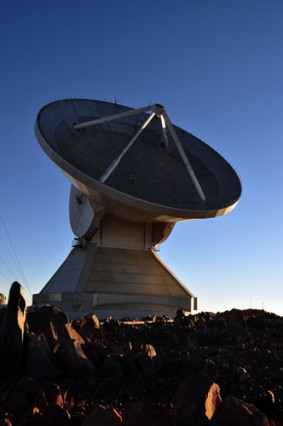
The Large Millimeter Telescope is a 50-m diameter single-dish telescope located atop Sierra Negra (4,600 m ASL) in the state of Puebla, Mexico, and is optimized to explore the structures in the Universe with astronomical observations at millimeter wavelengths (0.85 mm < λ < 4 mm).
The Large Millimeter Telescope (LMT), designed by MAN Technologie, is a 50-m diameter single-dish telescope optimized for astronomical observations at millimeter wavelengths (0.85 mm < λ < 4 mm). The LMT Project is a bi-national collaboration between México and the U.S.A. The institutions leading this effort are the Instituto Nacional de Astrofísica, Óptica y Electrónica (INAOE) and the University of Massachusetts at Amherst (UMass) respectively.
A principal scientific goal of the LMT is to understand the physical processes of structure formation and its evolutionary history throughout the Universe. More specifically, the LMT has the capability to investigate subjects as diverse as the constitution of comets and planetary atmospheres, the formation of extra-solar planets and the birth and evolution of stars, the hierarchical growth of galaxies and clusters and their large-scale distribution, as well as the cosmic microwave background and its anisotropies.
The selected telescope site of Volcán Sierra Negra (lat. ~ +19°), situated ~ 100 km east of INAOE, in the Mexican state of Puebla, is at an altitude of 4,600 m (15,000 ft.) and provides excellent millimeter wavelength transmission throughout the year.
The LMT is an open-air telescope which has been designed to provide a pointing accuracy better than 1 arcsec under median wind-loading conditions (v < 5 m/s). Following the characterization and correction of the telescope surface under the typical deforming effects of wind, gravity and temperature gradients, an r.m.s. accuracy of 98 micron has been achieved. The LMT metrology team will continue to perform photogrametry measurements to further improve the primary surface accuracy down to the expected 75 micron r.m.s.
The combination of the atmospheric transmission above the LMT site, the large collecting-area of the telescope, and the available field-of-view (up to 8 arcminutes in diameter) provides the LMT with extremely fast mapping-speeds. This advantage has been exploited by the first-light instruments and, since 2018, by new and near future instruments that include a variety of continuum array cameras, heterodyne arrays and wide-band receivers, and a large flexible auto-correlator spectrometer. An on-going program of instrument development and collaborative access to the telescope for guest instruments will ensure that the LMT remains a leading millimeter-wavelength facility.
The ASTRO 2020 white paper is available here, and a technical status summary of the LMT (October 2019) is available in this technical paper.
Additional information on the LMT and its scientific impact can be found in the LMT Book.